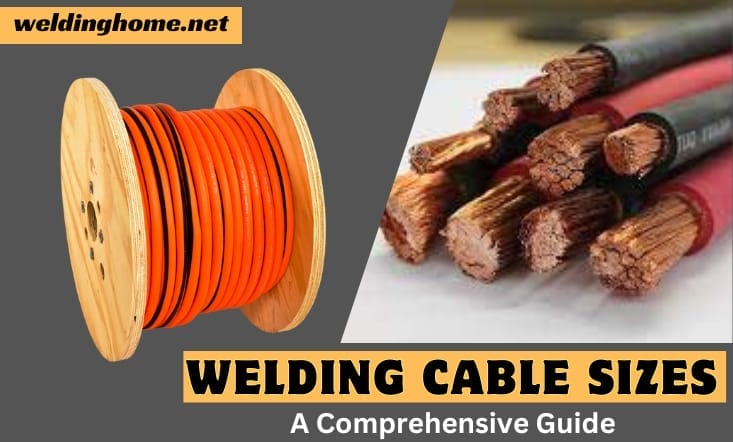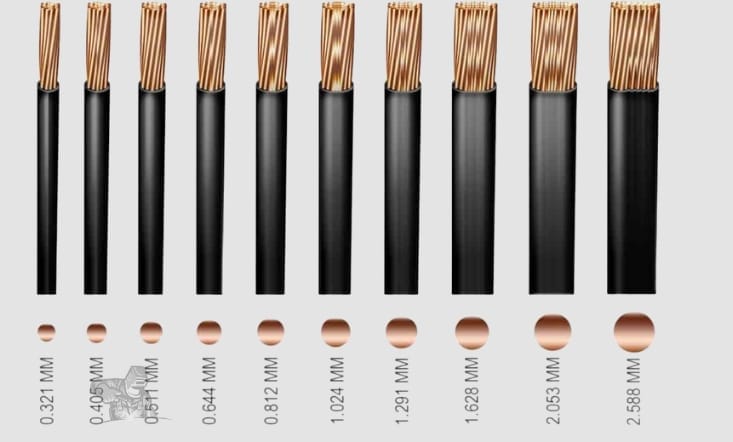How to Measure the Welding Cable Size? Charts & Tips for the Right Choice

In welding, accuracy and safety are vital; thus, knowing welding cable sizes is essential. The appropriate cable size may make or break a welding job.
Have you ever struggled with welding cable-size charts and tables? You’re not alone if they’ve confused you. Several welders experience this issue. I will simplify the procedure in this detailed guide so you can reliably choose the right welding cable size.
This work is crucial. It affects welding Cable Sizes, safety, and equipment lifespan. By following this guide’s practical techniques, you can make educated judgments and overcome those confusing charts.
Let’s learn How to measure the Welding Cable Sizes. Charts & Tips for the Right Choice
Quick Guide to Selecting the Right Welding Cable Sizes
If you’re eager to get to the heart of the matter, let’s jump into the practical steps for picking the correct Welding Cable Sizes. If you need more detailed insights, don’t worry; I’ll explore each step comprehensively in the following sections.
Step 1: Measure Your Welding Circuit Length

To begin, measure the total length of your welding circuit. This encompasses the power source, electrode cable, work cable, and all other components in your setup. Sum up the lengths of the electrode and work cables to calculate your total circuit length.
Step 2: Understand Your Power Source Output
You must know the maximum output of your welding power source. This information is typically found in the machine’s name or operating manual and is measured in amperage (amps).
Step 3: Examine the Duty Cycle
Check for the duty cycle rating of your welding power source. The duty cycle is expressed as a percentage, indicating how long your machine can operate at its maximum output within ten minutes without overheating.
Step 4: Utilize a Cable Size Chart
Once you’ve gathered your measurements and ratings, refer to the cable size chart below to identify the recommended size based on your total circuit length and power source output.
How do we measure the welding cable sizes?
This chart simplifies the selection of the correct cable size based on your welding requirements:
| Current (amps) | Duty Cycle (%) | Recommended Cable Size for Different Circuit Lengths (AWG) |
|---|---|---|
| 125 | 30 | 6 (0 to 50 ft.), 5 (51 to 100 ft.), 4 (101 to 150 ft.), 3 (151 to 200 ft.) |
| 150 | 40 | 6 (0 to 50 ft.), 5 (51 to 100 ft.), 3 (101 to 150 ft.), 2 (151 to 200 ft.) |
| 180 | 30 | 6 (0 to 50 ft.), 5 (51 to 100 ft.), 3 (101 to 150 ft.), 2 (151 to 200 ft.) |
| 200 | 60 | 4 (0 to 50 ft.), 4 (51 to 100 ft.), 3 (101 to 150 ft.), 2 (151 to 200 ft.) |
| 250 | 60 | 3 (0 to 50 ft.), 3 (51 to 100 ft.), 2 (101 to 150 ft.), 1 (151 to 200 ft.) |
| 300 | 60 | 2 (0 to 50 ft.), 2 (51 to 100 ft.), 1 (101 to 150 ft.), 1/0 (151 to 200 ft.) |
| 350 | 60 | 1/0 (0 to 50 ft.), 1/0 (51 to 100 ft.), 1/0 (101 to 150 ft.), 2/0 (151 to 200 ft.) |
| 400 | 100 | 1/0 (0 to 50 ft.), 1/0 (51 to 100 ft.), 1/0 (101 to 150 ft.), 2/0 (151 to 200 ft.) |
| 500 | 60 | 2/0 (0 to 50 ft.), 2/0 (51 to 100 ft.), 2/0 (101 to 150 ft.), 3/0 (151 to 200 ft.) |
Recommended Cable Size for Different Circuit Lengths (AWG)
If you plan to upgrade your equipment or tackle more extensive projects, consider choosing a slightly larger cable size to avoid buying new cables later.
Risks of Incorrect Cable Size
Choosing the wrong welding cable sizes can have significant consequences:
- Overheating and Fire Hazards: Using a too-small cable for your current can cause overheating and pose a fire risk.
- Electrical Shock: Overheating can damage cable insulation, exposing you to electrical shocks.
- Inefficient Energy Use and Extra Costs: Oversized cables are costlier without delivering better performance.
- Reduced Ampacity: Length and temperature can decrease a cable’s safe current-carrying capacity.
- Equipment Damage: The wrong cable size can damage your welding equipment for a long time.
The right cable size is about performance, safety, and cost-efficiency.
Understanding AWG and Metric Cable Sizes
Let’s investigate how welding Cable Sizes are measured, making it easier to interpret charts and shop for cables.
American Wire Gauge (AWG)
In the United States, cable sizes are often categorized using the American Wire Gauge (AWG) system. Interestingly, the smaller the AWG number, the larger the cable diameter. For example, a #4 AWG cable is more significant than a #6 AWG cable. Larger sizes are expressed as zeros, like 1/0, 2/0, 3/0, etc.
Metric Cable Sizes

International options or specifications might use metric measurements, which express size in square millimeters (mm²), representing the cable’s cross-sectional area.
AWG vs. Metric: Making Comparisons
Conversions between AWG and metric sizes are possible, and a comparison chart can be handy. These charts typically show equivalent sizes in both systems.
| AWG Size | Metric Equivalent (mm²) | International Standard (mm²) |
|---|---|---|
| #6 | 13.3 | 10 |
| #5 | 16.8 | 16 |
| #4 | 21.1 | 25 |
| #3 | 26 | 25 |
| #2 | 33.6 | 35 |
| #1 | 42.4 | 50 |
| 1/0 | 53.5 | 50 |
| 3/0 | 67.4 | 70 |
| 3/0 | 85.0 | 95 |
| 4/0 | 107.2 | 120 |
Welding Cable Sizes typically range from #4 to #4/0 in AWG or their metric equivalents.
Ampacity: A Crucial Concept
Ampacity, or “amperage capacity,” represents the maximum electrical current that a cable can safely conduct. It’s essential for your welding project’s safety and effectiveness.
Factors Affecting Ampacity
Cable length, ohm rating, temperature, and ambient temperature influence ampacity. Understanding ampacity is vital because an overloaded cable is a safety hazard and can affect your welding performance.
Practical Tips
- Always check ampacity ratings when selecting a cable.
- Consider the length of your welding circuit.
- Factor in the working environment’s temperature.
By comprehending ampacity and selecting the right Welding Cable Sizes, you’re not merely picking a line but making an informed choice that ensures safety and optimal performance.
Extension Cables
Extension cables for welding function similarly to Welding Cable Sizes. They should be capable of handling the welder’s input amperage and voltage for the desired extension cable length.
- Welding extension cords extend your equipment’s reach, letting you operate further from the power source.
- Use an extension cable that matches your welder’s amperage and voltage to avoid overheating and performance difficulties.
- Consider current, circuit length, and duty cycle when choosing an extension cable with the right AWG for welding.
- Check and maintain extension cables to minimize fraying, damage, and incorrect storage.
- Choose the length of an extension cable that fits your project. However, longer cables may reduce electricity.
Tips for the Right Choice
- Take into consideration the overall length of your welding circuit.
- Find out what the maximum output of your welding power supply is.
- Check the duty cycle of the power supply you use for the welder.
- Consult a cable size chart to get the appropriate measurement.
- Consider the possibility of making improvements to the equipment in the future.
- When selecting a cable size, put performance and safety first.
- Learn the differences between the American Wire Gauge (AWG) and metric cable sizes.
- When it is required to do so, convert between AWG and metric sizes.
- Always make sure that the ampacity ratings of cables are checked.
- Take into account the length of your welding circuit as well as the temperature of the working environment.
Where to Purchase Cables
Welding Cable Sizes are available at various tool stores, but online platforms like Amazon are your best bet for the widest selection and convenience. Whether you buy cables by foot or as fixed lengths, you’ll find various options to suit your needs.
Conclusion
In the world of welding, selecting the correct Welding Cable Sizes is more than just a technicality; it’s a crucial safety and performance consideration. The choices you make today can affect the quality of your work, the lifespan of your equipment, and, most importantly, your well-being. So, follow these guidelines, use the cable size chart, and remember that safety always comes first.
FAQS
Why is picking the right size of Welding Cable?
Choosing the right wire size is important for safety, efficiency, and the life of the tools. The wrong size can cause burning, fire risks, and waste energy.
How do I find out how long my welding circuit is all together?
To find the total length of your circuit, add the sizes of the power source, electrode cable, work cable, and any other attached parts.
It’s important to know what ampacity is when welding wires.
The most power a wire can safely take is called its ampacity, also known as amperage capability. It’s important for safety and getting the best results from welding.
Should I pick a bigger cord in case I need to update my gear?
If you want to improve your gear or work on bigger projects in the future, consider getting bigger cords so you don’t have to replace them.




